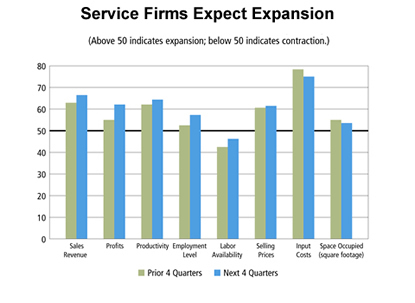Activity at firms that support businesses, such as accountants, architects, engineers and market researchers, was bustling over the past year and is expected to continue over the next four quarters, according to results of the annual survey of professional services firms, conducted in May and early June of 2007 by the Federal Reserve Bank of Minneapolis and the Minnesota Department of Employment and Economic Development.
The survey shows solid expansion in sales revenue, profits and productivity. The firms reported higher input costs and higher selling prices. Employment grew slowly over the past 12 months, partially due to a relatively thin supply of qualified workers. Therefore, there was only a small expansion in office space. Responding services firms expect continued growth in revenue and profits over the next four quarters. Meanwhile, both input costs and selling prices are expected to increase. Firms do not plan to add many employees or much office space. They also anticipate decreased consumer spending and rising inflation in the overall economy.

Firm revenue increased across the district over the past year, with 52 percent of respondents reporting higher revenue and 24 percent reporting lower revenue. Part of this revenue increase is due to higher selling prices for their products. While final prices rose, so did input costs, as 63 percent reported higher costs and only 4 percent reported decreasing costs. "Health care costs are out of control," commented a respondent from Minnesota. Other respondents may agree, as 18 percent reported benefits per worker increasing by more than 6 percent. On average, respondents saw a 2.9 percent increase in wages over the past year. Even with the higher costs, 43 percent of the respondents reported higher profits compared with 30 percent who reported lower profits. The higher wages and benefits were somewhat offset by higher productivity, as 36 percent reported increases and only 13 percent saw decreases over the past 12 months.
The tight availability of labor may have dampened employment and related space occupied. Employment edged up, with 21 percent reporting more employees over the past 12 months compared with 15 percent reporting reduced employment. Employers also added some space to house the new employees, with 14 percent increasing their square footage and only 4 percent reducing the space occupied.
The outlook for the next four quarters is bright. Service businesses plan to increase sales revenue by raising prices and output. They plan to increase output by adding employees and increasing productivity and office space. In addition, input costs are expected to increase. It appears that the increase in revenues will exceed the increase in costs, as 44 percent of the respondents expect increased profits over the next 12 months.
The outlook for the overall economy is not as bright. Respondents' expectations for the overall economy for the next four quarters are mixed with lower consumer spending but higher inflation expected.
See complete survey results. [xls]
Ninth District Professional Business Services Survey Methodology – June 2007Of the approximately 20,000 Ninth District professional business services firms (most firms in NAICS code 541), a stratified random sample of 2,217 businesses was drawn from the population. For each state, the population was stratified based on employment size; the sample includes 100 percent of establishments with more than 49 employees, 30 percent with 5 to 49 employees and 4 percent with fewer than 5 employees. A postcard survey was mailed to each of the selected businesses. The mailing was sent in mid-May, and a second mailing was sent in early June to businesses that did not respond to the first mailing. A cutoff for survey responses was June 14. A total of 354 usable surveys were received, for a response rate of 16 percent. Survey results were tabulated for all professional business services firms. The confidence interval for sampling error was calculated. The 95 percent confidence interval for the results is plus or minus 5.2 percentage points. Results are also subject to errors introduced by other factors, such as the wording of questions and differences between survey respondents and nonrespondents. Note: The Minnesota Department of Employment and Economic Development produced and processed the surveys for Minnesota firms, and the Federal Reserve Bank of Minneapolis conducted the survey for manufacturers in Montana, North and South Dakota, Ninth District counties in western Wisconsin and the Upper Peninsula of Michigan. |





